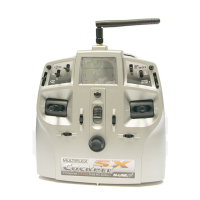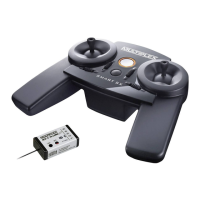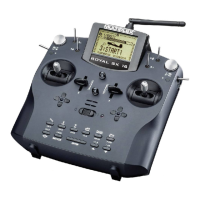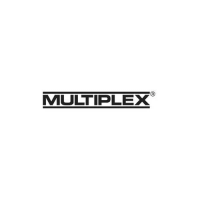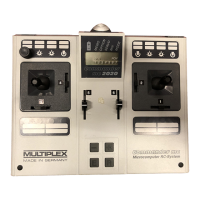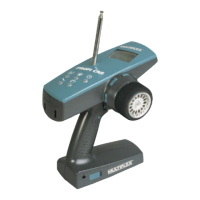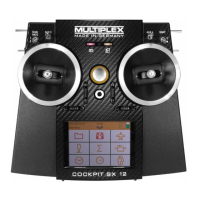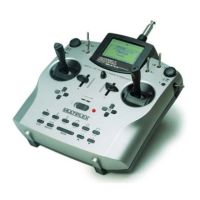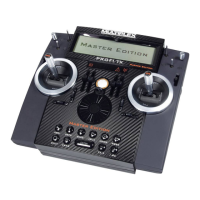1. Contents
1. Contents 1
2. Introduction 5
3. Safety Notes 5
3.1. General Safety Notes .........................................6
3.2. Range checking..................................................7
4. Liability exclusion 8
5. Guarantee 8
6. CE Conformity Declaration 8
7. Specification 9
7.1. Notes on channels / frequencies ........................9
7.2. Channel / Frequency Tables ..............................9
8. The transmitter battery 10
8.1. Introduction.......................................................10
8.1.1. Transmitter battery fuse ! 10
8.2. Charging the transmitter battery
(normal charge) ................................................10
8.3. Charging the transmitter battery (fast charge)..10
9. The transmitter 11
9.1. The external controls ........................................11
9.2. The screen........................................................12
9.3. The back of the transmitter...............................12
9.3.1. Setting the ratchet for the throttle / spoiler stick 12
9.3.2. Changing the stick centring spring tension 12
9.4. Inside the transmitter ........................................13
9.5. More about the hardware .................................13
9.5.1. Transmitter aerial / storage compartment 13
9.5.2. Multi-function socket with sliding cover 13
9.5.3. Operating the sliders from above / the side 13
9.5.4. Replacing the transmitter battery 13
10. First use 14
10.1. Charging the transmitter battery.......................14
10.2. Switching on .....................................................14
10.2.1. Activating the frequency / channel
(transmitters without Channel-Check PLUS) 14
10.2.2. Moving to the menus
without transmitting an RF signal 14
10.2.3. What does it mean if
“THR >0” appears on the screen? 14
10.2.4. Activating the frequency / channel
with the optional Channel-Check PLUS fitted 14
10.3. Setting the frequency / channel........................15
10.4. The RF status indicator (blue LED) ..................15
11. The 3-D digi-adjustor 16
11.1. Basic function ...................................................16
11.2. Typical application
Changing the menu text language....................16
12. Transmitter settings and INFO displays17
12.1. Transmitter settings
Menu: (
SETUP) TRANSM ................................17
12.1.1. Battery alarm threshold
Menu:
(SETUP, TRANSM) BAT AL 17
12.1.2. Language for menu texts
Menu: (
SETUP, TRANSM) TEXT 17
12.1.3. Owner’s name
Menu: (
SETUP, TRANSM) NAME 17
12.1.4. Complete transmitter reset
Menu:
(SETUP, TRANSM) RESET 18
12.1.5. Version information
Menu:
(SETUP, TRANSM) -VER- 18
12.2. The INFO displays ............................................18
13. Setting up a new model
Model type: EASY 19
13.1. What does EASY mean ?.................................19
13.2. Preparing the model .........................................19
13.3. Preparing the transmitter ..................................20
13.3.1. Setting up a new model memory for EASY
Menu: (
MEMO) NEW 20
13.3.2. Setting the stick mode
(which stick controls which function?)
Menu: (
SETUP) MODE 20
13.3.3. Transmitter controls for the EASY type 21
13.3.4. Selecting idle forward / back
Menu: (
SETUP, MODEL) TH R 21
13.3.5. Setting Throttle Check
Menu: (
SETUP, MODEL) TH CHK 21
13.4. Adjusting servos ...............................................22
13.4.1. Reversing the direction of servo rotation
Menu: (
SERVO) REV 22
13.4.2. Adjusting the servo centre
Menu: (
SERVO) CENTR 23
13.4.3. Setting servo (control surface) travels
Menu: (
SERVO) TRAVL 23
13.5. Mixers
Menu: MIXER ..................................................24
13.5.1. Mixers operating on elevator 24
13.5.2. Adjusting the throttle / elevator mixer
Menu: TH -CO 24
13.5.3. Adjusting the SPOILER/FLAP / elevator mixer
Menus: SP -CO, F -CO 25
13.6. Transmitter control settings
Menu: CONTRL................................................25
13.6.1. Dual Rates for AILERON, ELEVATOR, RUDDER
Menu: (
CONTRL) DR 25
13.6.2. Setting the exponential function
Menu: (
CONTRL) EXP 26
13.7. More features which can be exploited
with the EASY model type ................................27
13.7.1. Controlling V-tail models
Menu: (
MIXER) V-TAIL 27
13.7.2. Deltas and flying wings
Menu: DELTA 27
13.7.3. Changing the default assignment of receiver output 4
(throttle / speed controller)
Menu: (
MIXER) TH >S4 28
13.8. Additional mixer functions.................................28
13.8.1. Combi-Switch mixer
Menu: (
MIXER) COMBI 28
13.8.2. Aileron travels and differential
Menu: (
MIXER) AI->AI 28
13.8.3. “Ailerons raised” as landing aid (mixing SPOILER into
AILERON) Menu: (
MIXER) SP ->AI 29
13.8.4. Changing wing camber using the ailerons (flap, speed
/ thermal setting) Menu: (
MIXER) F ->AI 30
13.8.5. Electronic Y-lead Menu: (
MIXER) Y-LEAD 30
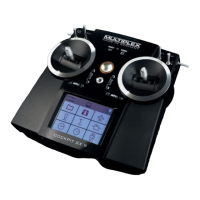
